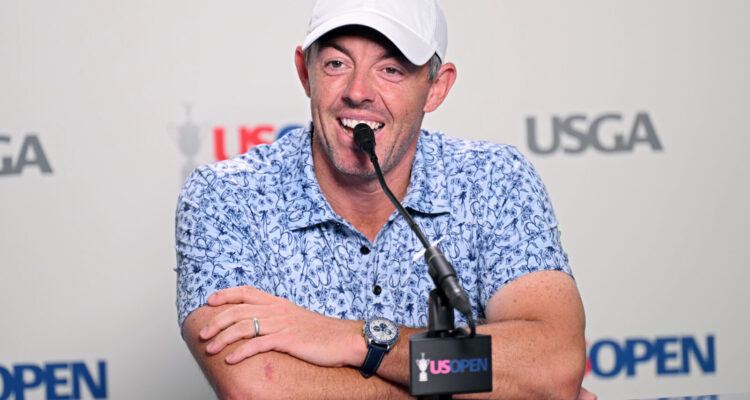Rory Mcllroy gives an pre tournament interview on the eve of the US Open at Oakmont
Just your initial reaction to the golf course and maybe a bit about what you remember from 2016?
RORY McILROY: Yeah, don’t really remember much about 2016. I think I just tried to erase it from the memory bank. Then yeah, look, it’s Oakmont. Even though Gil has come in here and done his thing, it’s still a big brute of a golf course, and you’re going to have to have your wits about you this week all the way throughout the bag, off the tee, into the greens, around the greens.
So yeah, look, everyone knows what to expect. It’s Oakmont. It’s going to be a great test.
Q. Rory, I know the driver plays a role, but if the ball has been getting away from you off the tee, there’s presumably some technical thing going on. Just wondering what you’ve identified in your swing and what you’re working on.
RORY McILROY: Yeah, I think it’s a little bit of both. I think especially trying to — hitting a lot of drivers, every driver sort of has its own character and you’re trying to manage the misses. It’s definitely a little bit of both.
I feel like, as the last few weeks go, I think I learnt a lot on Thursday and Friday last week and did a good bit of practice at home and feel like I’m in a better place with everything going into this week.
Q. What did you learn at home?
RORY McILROY: I learned that I wasn’t using the right driver. (Laughter.)
Q. Rory, you told us at the PGA that you’ve accomplished everything you want to accomplish in the game. Feels like there’s kind of Phase 2 happening right now of Rory McIlroy’s life. What is your five-year plan for this next phase of Rory?
RORY McILROY: I don’t have one. I have no idea. I’m sort of just taking it tournament by tournament at this point.
Yeah, I have no idea.
Q. I know it’s probably a good problem to have, coming off the Grand Slam, but what is the difficulty of kind of resetting in these last couple of weeks, and what’s the challenge that you’ve found the last two tournaments at least, and as you go forward?
RORY McILROY: I think it’s trying to have a little bit of amnesia and forget about what happened six weeks ago. Then just trying to find the motivation to go back out there and work as hard as I’ve been working. I worked incredibly hard on my game from October last year all the way up until April this year. It was nice to sort of see the fruits of my labor come to fruition and have everything happen.
But at the same time, you have to enjoy that. You have to enjoy what you’ve just accomplished. I certainly feel like I’m still doing that and I will continue to do that.
At some point, you have to realize that there’s a little bit more golf left to play this season, here, Portrush, Ryder Cup, so those are obviously the three big things that I’m sort of looking at for the rest of the year.
But I think weeks like Quail Hollow or even weeks like last week, it makes it easier to reset in some way, to be like, okay, I sort of need to get my stuff together here and get back to the process and sort of what I’d been doing for that seven months from October last year until April this year.
Q. Have you settled on a driver that you want to use this week, first of all?
RORY McILROY: Yeah.
Q. What is it?
RORY McILROY: A TaylorMade. (Laughter.)
Q. What model?
RORY McILROY: I mean, come out and watch me hit balls, and you’ll see.
Q. Going back to the PGA, how big a factor was it that you didn’t have that gamer driver that you had used at the Masters?
RORY McILROY: It wasn’t a big deal for Scottie, so it shouldn’t have been a big deal for me.
Q. How tough is it to regain that motivation, and did you think it might be this difficult to regain motivation?
RORY McILROY: I didn’t know — look, you dream about the final putt going in at the Masters, but you don’t think about what comes next.
I think I’ve always been a player that struggles to play after a big event, after I win whatever tournament. I always struggle to show up with motivation the next week because you’ve just accomplished something and you want to enjoy it and you want to sort of relish the fact that you’ve achieved a goal.
I think chasing a certain goal for the better part of a decade and a half, I think I’m allowed a little bit of time to relax a little bit. But here at Oakmont, I certainly can’t relax this week.
Q. In the aftermath of the Masters Tournament, a lot more demands on your time, even more so than usual. What have you been doing off of the golf course to kind of get back to baseline, and in the personal sense, outside of golf?
RORY McILROY: Yeah, basically saying no to every request that comes in, trying to get home as much as possible, and trying to do the things that I enjoy. That was one of my goals for this year was to have more fun, and that’s what I’m trying to do.
I’m trying to have more fun. We’re trying to take more trips. We’re trying to — yeah, just trying to do things that I enjoy and get back to having hobbies and filling my time with the things that I want to do. I think that’s been a big — but that hasn’t just been post-Augusta. I’ve been trying to do that for a while.
I’ve started to play a lot of tennis again. Like Harry and Niall play tennis pretty much every week when we’re on the road, and I’ve always been like, I don’t want to injure myself, whatever, but I miss not playing. So Harry and I played quite a bit of tennis last weekend, so that was good fun.
Again, just, like, traveling and seeing the world and giving Poppy that opportunity to see the world at such a young age I think is a wonderful opportunity for her. Just that sort of stuff.
Q. When you won this in ’11, the golf course was soft, so there was this reputation building that soft was your friend, and you mentioned ’16, and that was the soft part of the resume for you with respect to this championship, and then the last six years you’ve been as good as anybody and you’re also really good on firm conditions. Explain the evolution of you being as good as you are in this championship now and also on firm conditions. Is it psychological? Is it ego driven? Is it physical? What is it?
RORY McILROY: I think it’s probably a combination of both, or everything. I didn’t like that reputation because I felt like I was better than that reputation, so that’s ego driven in some way.
But I allude to this all the time. I missed the cut at the U.S. Open in 2016, 2017 and 2018, and we were here in ’16, Erin Hills in ’17, which is what it is, and then 2018 at Shinnecock I felt — Shinnecock was a really hard one because I love that golf course, and to perform the way I did there, it really hurt me.
I made a decision to be like, okay, I want to — and then I would go back, I’d play Hartford the next week and I’d feel really comfortable on a PGA TOUR setup, and then I think it was that week where it clicked. It was like, why am I so comfortable here in Hartford but last week I had no clue what to do? So that’s when I made the decision at that back end of 2018 into 2019, I want to try to build my game around the toughest tests that we have in the game.
Then as you’ve seen since 2019, six top 10s in a row at this tournament, obviously finished second the last two years in a row, and I’ve definitely become a much more confident U.S. Open player and I’m way more comfortable on those firm, fast setups like you saw at Pinehurst last year and LACC the year before that.
Obviously the U.S. Open went from probably my least favorite major to probably my favorite because of what it asks from you, and I love that challenge.
Q. This might be a little bit of a silly question, but how much more of a factor is just finding the ball in the rough this week, let alone hitting it, compared to other U.S. Opens, other majors, other tournaments?
RORY McILROY: Yeah, I’m glad we have spotters up there because I played last Monday just in Druck’s outing, and you hit a ball off the fairway and you were looking for a good couple of minutes just to find it. It’s very penal if you miss. Sometimes it’s penal if you don’t miss. But the person with the most patience and the best attitude this week is the one that’s going to win.
Q. Besides the lost ball element, what did you learn about the course on your scouting trip, and what have you seen in how it’s changed in the weeks since then?
RORY McILROY: Yeah, there’s definitely been a little bit of rain since that Monday. Last Monday felt impossible. I birdied the last two holes for 81. It felt pretty good. It didn’t feel like I played that bad.
It’s much more benign right now than it was that Monday. They had the pins in dicey locations, and greens were running at 15 1/2. It was nearly impossible.
But yeah, this morning it felt — it was a little softer. The pins aren’t going to be on 3 or 4 percent slopes all the time. If you put it in the fairway, it’s certainly playable. But then you just have to think about leaving your ball below the hole and just trying to make as many pars as you can. You get yourself in the way of a few birdies, that’s a bonus.
Q. Rory, at THE PLAYERS you didn’t drive it great, at least early in the week, but yet you overcame it, fought your way through it and shot some good scores and obviously won. Is anything the same or similar that you’re going through now with that, and how do you sort of get through it when you’re having a tough day off the tee?
RORY McILROY: Yeah, PLAYERS, the rough is short. They probably cap it at two, two-and-a-half inches, and then if you go off the fairway, you’re in pine straw where you have a shot if you have a gap in the trees. It’s definitely more of a — you can play recovery golf at THE PLAYERS. This place won’t let you do that. You’ve got to chop it out and then just try to make a par with a wedge in your hand.
I felt like I drove the ball okay at Augusta, but again, it’s a recovery golf course. You hit it offline, you can find gaps in trees and you can do something with it. You miss a fairway here, you can’t really do anything with it unless you’re in the middle of a fairway bunker and you can get something over the lip.
Much more penal if you do miss it, and hopefully — I feel a little better with the driver over the weekend at home and even today playing a practice round, so hopefully I can hit a few more fairways than I have been hitting and give myself some opportunities.
Q. You mentioned just having to chop out every time you miss a fairway. Are there ever calculations where you might decide to go for it, and what would go into that thinking if a ball is in the rough?
RORY McILROY: Yeah, just the lie. Just whatever club you think you can get on it. If there’s a bunker to cover, if there’s — the good thing about this course is most of the greens have run-ups onto them. It’s not as if they’re forced carries on to greens. So if you have a half-decent lie in the rough, it gives you a chance to at least run the ball up to the front of the green if you’ve got a decent lie.
But decent lies in the rough are few and far between, so that’s why you have to — you don’t want to ride your luck on this golf course.
Q. Just a question about length versus strength. Is strength maybe more important at this golf course than most U.S. Opens, and is it maybe more important than length this week?
RORY McILROY: Look, you hit the ball in the rough and you’re not going to have any control of your ball going into the green, especially these greens that are pitched away from you. You have to be able to spin the ball going into these greens if you want it to finish anywhere close to where you want it to.
Saying that, the last two champions here did lead the field in driving distance. I watched quite a lot of 2016 over the weekend and just tried to get a feel for how the leaders played this golf course and what they did that I certainly didn’t do over the first two days.
But yeah, you’ve got DJ who obviously won and Cabrera in ’07. But you had a mix of players that were up there. You had Jim Furyk finished second in ’16.
So I think there’s different styles of games that can win here, but I certainly think that distance is never a disadvantage, and especially on this golf course.
But you want to combine distance with accuracy this week. That’s the recipe.
Q. Going back your whole professional career and even your amateur career, you’ve always been very skillful and comfortable talking about yourself and talking about this game. Not everybody is. I’m wondering where that comes from.
RORY McILROY: Probably because I love myself and I love golf. I’m pretty comfortable talking about both of those things.
Q. Did you have a kind of mentor for that sort of thing, Chubby or anybody else give you advice on how to do it?
RORY McILROY: No, not really. I think you’re always going to be really comfortable talking about subjects that you feel like you know a lot about, and I think I know a lot about golf, and especially my golf. There’s no one better to tell you about my game and what I’m thinking and how I’m feeling than me.
I’ve always enjoyed that. I’ve always enjoyed talking about the game. I’ve always enjoyed the challenge that it presents physically and mentally and trying to figure out a way to overcome those challenges.
Q. And your dad is a good talker?
RORY McILROY: My dad can talk with the best of them, yes.



